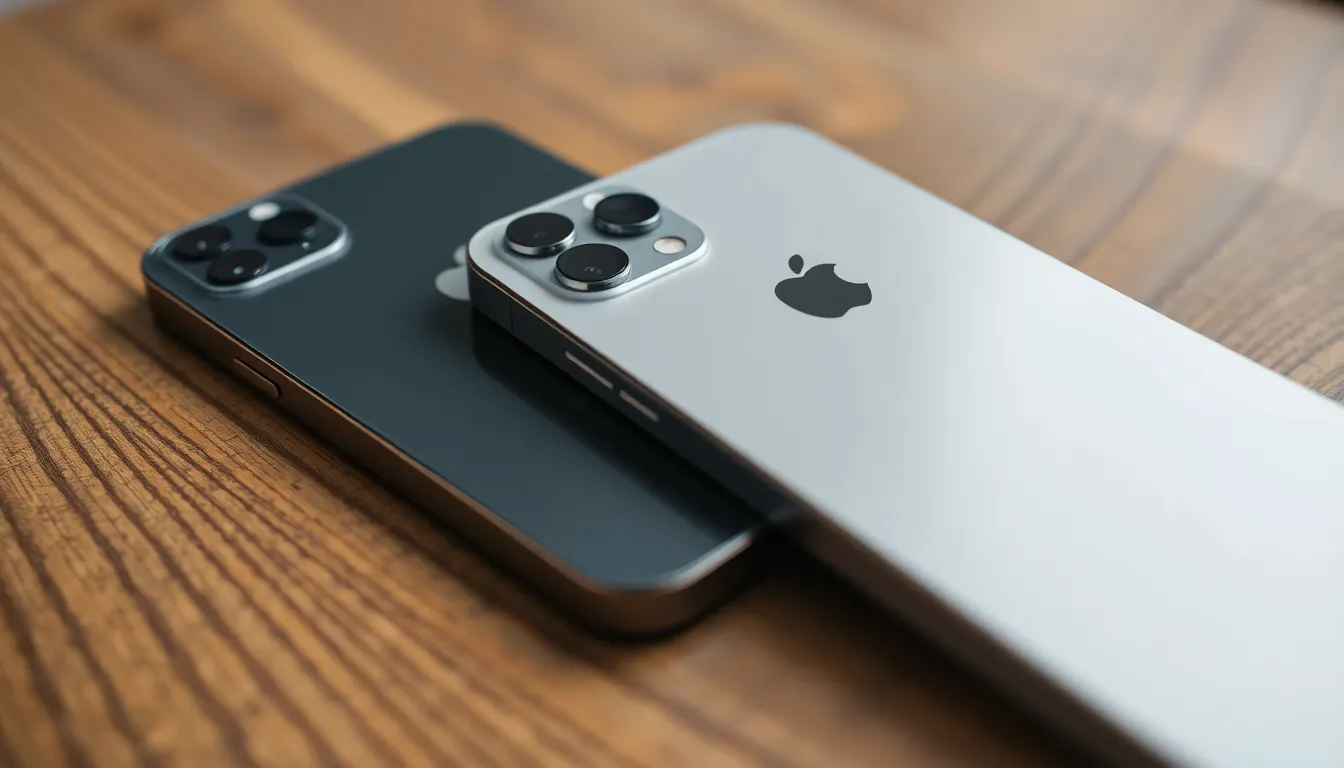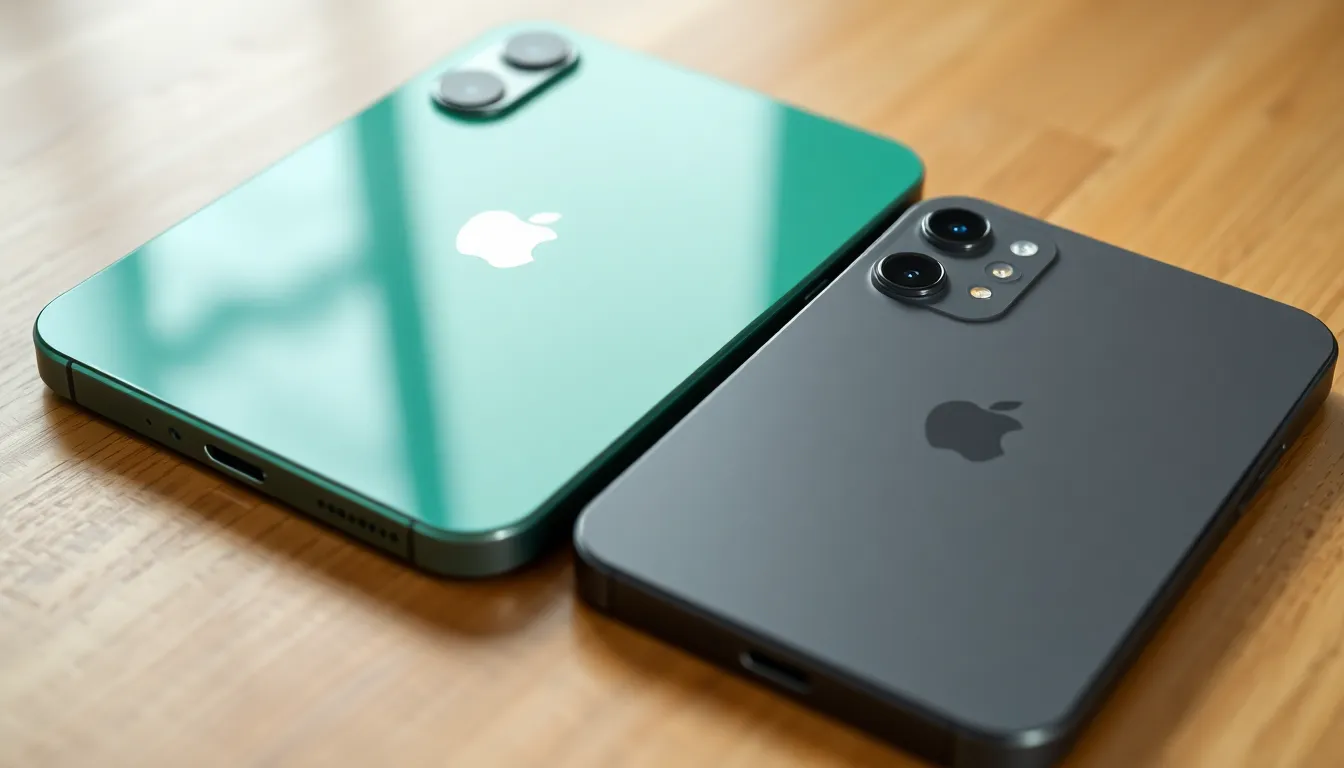When it comes to choosing an iPhone, size matters—just ask anyone who’s ever tried to squeeze a Plus model into their skinny jeans. The iPhone 11 and iPhone 11 Pro might seem like twins at first glance, but are they really the same size? Spoiler alert: they’re not, and understanding the differences could save you from some serious buyer’s remorse.
Table of Contents
ToggleOverview of iPhone 11 and iPhone 11 Pro
iPhone 11 measures 150.9 x 75.7 x 8.3 mm and weighs 194 grams. iPhone 11 Pro, in contrast, has dimensions of 144 x 71.4 x 8.1 mm, weighing 188 grams. The difference in size between these two models is noticeable, especially for users prioritizing portability and ease of use.
Both models feature a 6.1-inch Liquid Retina LCD for iPhone 11 and a 5.8-inch Super Retina XDR display for iPhone 11 Pro. The screens offer different experiences, with the Pro model providing deeper blacks and enhanced contrast. Resolutions also vary; iPhone 11 offers 1792 x 828 pixels, while iPhone 11 Pro boasts 2436 x 1125 pixels.
Colors available for iPhone 11 include Black, Green, Yellow, Purple, Red, and White. Meanwhile, iPhone 11 Pro comes in more muted colors: Space Gray, Silver, Gold, and Midnight Green. These color options cater to different aesthetic preferences while maintaining distinctiveness in the lineup.
Battery life also varies; iPhone 11 can last up to 17 hours during video playback, while iPhone 11 Pro lasts about 18 hours. Charging methods remain similar, with both models supporting fast charging and wireless charging as options.
Camera capabilities contribute to the models’ appeal. iPhone 11 features a dual-camera system, including ultra-wide and wide lenses. iPhone 11 Pro, however, enhances photography with a triple-camera system, adding a telephoto lens for more versatile shooting.
Although both iPhone models share some characteristics, the differences in size, display technology, battery life, color options, and camera capabilities make them unique. Selecting between the two involves considering personal preference and specific usage requirements.
Design Comparisons

Understanding the design differences between the iPhone 11 and the iPhone 11 Pro helps buyers make informed choices. Both models, though similar in appearance, showcase distinct design elements.
Dimensions and Weight
The iPhone 11 measures 150.9 x 75.7 x 8.3 mm and weighs 194 grams. In contrast, the iPhone 11 Pro is more compact, with dimensions of 144 x 71.4 x 8.1 mm and weighing 188 grams. Those who prioritize portability may find the size reduction in the Pro model appealing. While both phones fit comfortably in the hand, subtle variations in size create different user experiences.
Build Materials
Materials used in construction set the two models apart. The iPhone 11 features an aluminum frame and glass back, creating a durable, yet slightly heavier device. The superior build quality of the iPhone 11 Pro comes from its stainless steel frame with a textured matte glass back, providing a premium feel. The choice of materials impacts not just aesthetics but durability as well, making the Pro model more resilient to wear and tear.
Display Characteristics
Display specifications significantly affect user experience. The iPhone 11 and iPhone 11 Pro showcase different screen sizes and resolutions that impact visual clarity.
Screen Size and Resolution
Screen size varies between the iPhone 11 and iPhone 11 Pro. The iPhone 11 features a 6.1-inch display with a resolution of 1792 x 828 pixels, offering adequate clarity for everyday tasks. In contrast, the iPhone 11 Pro has a smaller 5.8-inch screen, delivering a resolution of 2436 x 1125 pixels. This higher resolution allows for crisper images and text. Users seeking vibrant visuals may prefer the iPhone 11 Pro, while those who like larger displays might find the iPhone 11 appealing.
Display Technology
Display technology also plays a crucial role in user satisfaction. The iPhone 11 uses a Liquid Retina LCD that delivers decent color accuracy. On the other hand, the iPhone 11 Pro utilizes Super Retina XDR technology, providing deeper blacks and enhanced contrast. This combination ensures better performance in various lighting conditions. Higher brightness capabilities in the iPhone 11 Pro enhance visibility outdoors, making it a superior choice for photography and content consumption. Users can select based on their priority for either display size or cutting-edge technology.
Performance Specifications
Performance specifications significantly impact user experience when comparing the iPhone 11 and iPhone 11 Pro. Both models feature cutting-edge technology, affecting speed and efficiency.
Processor and RAM
The iPhone 11 utilizes the A13 Bionic chip, ensuring fast performance across applications. It contains 4 GB of RAM, providing smooth multitasking capabilities. In contrast, the iPhone 11 Pro also houses the A13 Bionic chip but offers the same 4 GB of RAM for enhanced efficiency. Users benefit from high-speed processing and gaming experiences that perform seamlessly on both devices.
Battery Life
Battery life stands as a key differentiator between the two models. The iPhone 11 lasts up to 17 hours during video playback, while the iPhone 11 Pro features a slightly longer battery life of around 18 hours. Both devices support fast and wireless charging, enhancing convenience for users on the go. Despite the smaller size, the iPhone 11 Pro maintains robust performance, giving users lasting power for daily tasks.
Camera Capabilities
Camera capabilities play a significant role in the decision-making process between the iPhone 11 and iPhone 11 Pro. While both models boast impressive photography features, they cater to different user needs.
Rear Camera Systems
The iPhone 11 includes a dual-camera system, featuring a 12 MP wide lens and a 12 MP ultra-wide lens. This setup allows users to capture stunning landscapes and group photos. Consider the iPhone 11 Pro, which incorporates a triple-camera system with an additional 12 MP telephoto lens. The telephoto lens provides 2x optical zoom, facilitating portrait shots with great depth. Low-light performance distinguishes both models, with Night mode enhancing photo quality in dim settings. Moreover, users of the iPhone 11 Pro enjoy improved computational photography features, delivering professional-grade results with minimal effort.
Front Camera Features
The front camera on the iPhone 11 and iPhone 11 Pro offers a 12 MP sensor capable of recording 4K video. Both models enable users to create high-resolution selfies. Portrait mode enhances depth effects, while the addition of Night mode improves low-light performance significantly. Each model also supports Animoji and Memoji features for personalized expressions. Although their front cameras are similar, users seeking superior video recording capabilities and higher frame rates might prefer the iPhone 11 Pro’s enhanced features. TrueDepth technology powers both cameras, providing exceptional face recognition for secure unlocking and Apple Pay.
Usability and User Experience
Usability and user experience play significant roles in differentiating the iPhone 11 and iPhone 11 Pro. Their design impacts how comfortable users feel while interacting with the devices throughout their daily activities.
Ergonomics and Comfort
Ergonomics significantly affect user satisfaction. The iPhone 11’s dimensions of 150.9 x 75.7 x 8.3 mm provide a larger surface area, which some users find appealing for media consumption and gaming. On the other hand, the iPhone 11 Pro’s smaller size of 144 x 71.4 x 8.1 mm makes it easier to hold with one hand, enhancing portability. Weight also plays a role; the iPhone 11 weighs 194 grams, which can feel bulkier than the 188-gram iPhone 11 Pro. Therefore, users valuing portability and ease of handling may prefer the 11 Pro.
Software Features
Software features further enhance the user experience. Both models run iOS, which delivers a smooth interface and access to numerous apps. Performance is comparable due to the A13 Bionic chip, ensuring quick app launches and smooth multitasking. Specific features, such as Night mode for photography, function equally well on both devices, but the iPhone 11 Pro offers enhanced video capabilities. Users focusing on photography may appreciate the additional software enhancements that accompany the iPhone 11 Pro’s triple-camera system. Thus, each model offers distinct advantages, aligning with varying user preferences and needs.
Choosing between the iPhone 11 and iPhone 11 Pro involves more than just size. While the iPhone 11 is larger and offers a vibrant display with a dual-camera system, the iPhone 11 Pro provides a more compact design and superior camera features. Users seeking portability may prefer the Pro model, while those who enjoy media consumption might lean towards the iPhone 11. Each device caters to different preferences and needs. Ultimately, understanding these distinctions helps users make an informed decision that aligns with their lifestyle and usage habits.




